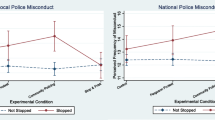Abstract
This article examines the impact on jurors of exposure to media coverage of legal issues. Jurors' decisions may be influenced by a broad range of legally relevant information gleaned from media sources, including newspaper reports, radio and television news, advertising, movies, and televised crime shows and courtroom scenes. The article gives examples of these influences from real-world cases and from simulated research studies. It focuses on the impact of trial-relevant publicity on jurors in cases unrelated to the one being publicized; the ways that media representations of the justice system may influence jurors' expectations and decisions; the influence of insurance company advertisements on jurors' damage awards; and the impact of viewing pornography on jurors' decision making. The paper also explores the psychological processes by which each of these effects may occur and evaluates proposed remedies.
Similar content being viewed by others
References
Anderson, J. R. (1981).Cognitive skills and their acquisition. Hillsdale, NJ: Erlbaum.
Barrile, L. (1984). Television and attitudes about crime: Do heavy viewers distort criminality and support retributive justice? In R. Surette (Ed.),Justice and the Media: Issues and research. Springfield, IL: Charles C. Thomas.
Bower, G. H., Black, J. B., & Turner, T. J. (1979). Scrips in memory for text.Cognitive Psychology, 11, 177–220.
Brewer, M. B., Dull, V., & Lui, L. (1981). Perceptions of the elderly: Stereotypes as prototypes.Journal of Personality and Social Psychology, 41, 656–670.
Carroll, J. S., Kerr, N. L., Alfini, J. J., Weaver, F. M., MacCoun, R. J., & Feldman, V. (1986). Free press and fair trial: The role of behavioral research.Law and Human Behavior, 10, 187–201.
Cocozza, J. C., & Steadman, H. J. (1978). Predictions in psychiatry: An example of misplaced confidence in experts.Social Problems, 25, 265–276.
Cook, T. D., & Flay, B. R. (1978). The persistence of experimentally induced attitude change. In L. Berkowitz (Ed.),Advances in experimental social psychology, 11, New York: Academic.
Court reschedules murder trial so jurors can't watch TV drama. (1984).Seattle Times, 11/18/84, p. A11.
Donnerstein, E., Linz, D., & Penrod, S. (1987).The question of pornography: Research findings and policy implications, New York: Free Press.
Estep, R., & Macdonald, P. T. (1984). How prime-time crime evolved on TV, 1976–1983. In R. Surette (Ed.),Justice and the media: Issues and research. Springfield, IL: Charles C. Thomas.
Gerbner, G., Gross, L., Eleey, M., Jackson-Beeck, M., Jeffries-Fox, S., & Signorielli, N. (1977). TV violence profile No. 8: The highlights.Journal of Communication, 27, 171–180.
Graber, D. A. (1980).Crime news and the public. New York: Praeger.
Greene, E., & Loftus, E. F. (1984). What's new in the news? The influence of well-publicized news events on psychological research and courtroom trials.Basic and Applied Social Psychology, 5, 211–221.
Greene, E., & Wade, R. (1987). Of private talk and public print: General pretrial publicity and juror decision making.Applied Cognitive Psychology, 2, 123–135.
Haney, C., & Manzolati, J. (1984). Television eriminology: Network illusions of criminal justice realities. In E. Aronson (Ed.),Readings about the social animal. New York: Freeman.
Hans, V. P., & Slater, D. (1983). John Hinckley, Jr. and the insanity defense: The public's verdict.Public Opinion Quarterly, 47, 202–212.
Hastie, R., Penrod, S., & Pennington, N. (1983).Inside the jury. Cambridge: Harvard University Press.
Henderson, P. (1981a). One man's battle to clear his name.Seattle Times, 5/15/81, D1-2.
Henderson, P. (1981b). Titus case.Seattle Times, 6/5/81, C1-2.
Kaplan, M. F. (1982). Cognitive processes in the individual juror. In N. Kerr & R. Bray (Eds.),The psychology of the courtroom. New York: Academic Press.
Kassin, S., & Wrightsman, L. S. (1988).The American jury on trial. New York: Hemisphere.
Krafka, C. (1985). Sexually explicit, sexually violent, and violent media: Effects of multiple naturalistic exposures on female viewers. Unpublished doctoral dissertation, University of Wisconsin.
Kramer, G. P., Kerr, N. L., & Carroll, J. S. (1990). Pretrial publicity, judicial remedies, and jury bias. This issue,Law and Human Behavior, 14, 409–438.
Linz, D. (1985). Sexual violence in the media: Effects on male viewers and implications for society. Unpublished doctoral dissertation, University, of Wisconsin.
Linz, D., Donnerstein, E., & Penrod, S. (1984). The effects of multiple exposures to filmed violence against women.Journal of Communication, 34, 130–137.
Loftus, E. F. (1979). Insurance advertising and jury awards.American Bar Association Journal, 65, 68–70.
Mitchell, H. E., & Byrne, D. (1973). The defendant's dilemma: Effects of juror's attitudes and authoritarianism on judicial decisions.Journal of Personality and Social Psychology, 25, 123–129.
Padawer-Singer, A., & Barton, A. (1975). The impact of pretrial publicity on jurors' verdicts. In R. J. Simon (Ed.),The jury system in America: A critical overview. Beverly Hills, CA: Sage.
Petty, R. E., Cacioppo, J. T., & Goldman, R. (1981). Personal involvement as a determinant of argument-based persuasion. Journal of Personality and Social Psychology,41, 847–855.
Quinn v. Aetna Life & Casualty Co., 96 Misc. 2d 545, 409 N.Y.S. 2d 473 (S. Ct., Queens County, 1978).
Sharf, B. F. (1986). Send in the clowns: The image of psychiatry during the Hinckley, trial.Journal of Communication, 36, 80–93.
Shipp, E. R. (1983). Message of “The Verdict” is debated.New York Times, 4/13/83, A12.
Simon, R. (1982). Score one for justice and the law.Chicago Sun-Times, 6/23/82, 7.
Snyder, M. (1984). When belief creates reality. In L. Berkowitz (Ed.),Advances in experimental social psychology, 18, New York: Academic.
Stroble v. California, 343 U.S. 181 (1952).
Tversky, A. & Kahneman, D. (1973). Avaitability: A heuristic for judging frequency and probability.Cognitive Psychology, 5, 207–232.
Visher, C. A. (1987). Juror decision making: The importance of evidence.Law and Human Behavior, 11, 1–18.
Yoder, E. (1982). The price we pay for insanity defense.Chicago Sun-Times, 6/25/82, 35.
Zillmann, D., & Bryant, J. (1982). Pornography, sexual callousness, and the trivialization, of rape.Journal of Communication, 32, 10–21.
Author information
Authors and Affiliations
Additional information
I thank Alan Siegel for his comments on an earlier draft.
About this article
Cite this article
Greene, E. Media effects on jurors. Law Hum Behav 14, 439–450 (1990). https://doi.org/10.1007/BF01044221
Issue Date:
DOI: https://doi.org/10.1007/BF01044221




